S.C. Skillman's Blog, page 47
November 22, 2016
Good Progress on New Novel “Director’s Cut”
I’m making good progress on my new paranormal suspense novel Director’s Cut, 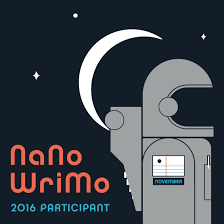 working towards 50,000 words for Nanowrimo.… and trying to follow my own advice in my article The writing process for creating a novel in less than a month.
working towards 50,000 words for Nanowrimo.… and trying to follow my own advice in my article The writing process for creating a novel in less than a month.
No writing for the rest of today as I’ll be in London, but since that’s where my novel is set I’ll be able to put the trip to good use for my ongoing research!
Meanwhile I hope to see some of you at my two books-signings this coming weekend; 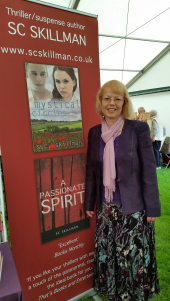 I’ll be at Kingsley School Hall, Beauchamp Ave, Leamington Spa CV32 5RD on Saturday 27th and at Princethorpe College, Rugby CV23 9PX on Sunday 28th selling signed copies of my two thriller suspense novels Mystical Circles and A Passionate Spirit.
I’ll be at Kingsley School Hall, Beauchamp Ave, Leamington Spa CV32 5RD on Saturday 27th and at Princethorpe College, Rugby CV23 9PX on Sunday 28th selling signed copies of my two thriller suspense novels Mystical Circles and A Passionate Spirit.
There’ll be plenty of lovely Christmas gifts and refreshments on both days, and remember: books make an ideal Christmas gift!
Filed under: Books, British, British psychological suspense writer, creative writing, New psychological thriller fiction, paranormal thriller fiction, SC Skillman, SC Skillman Author, UK, Writing Tagged: book signing, christmas gifts, nanowrimo, new novel, paranormal, SC Skillman, SCSkillman author, suspense, thriller, writing a novel


November 15, 2016
Book Signings in Warwickshire this Christmas
I shall be out and about in Warwickshire  signing copies of my two thriller suspense novels Mystical Circles and A Passionate Spirit at three Christmas Fairs in the next few weeks:
signing copies of my two thriller suspense novels Mystical Circles and A Passionate Spirit at three Christmas Fairs in the next few weeks:
Kingsley School Hall
Beauchamp Ave
Leamington Spa CV32 5RD
11am-2pm Saturday 26th November
Princethorpe College
Princethorpe
nr Rugby CV23 9PX
2-4.20pm Sunday 27th November
and
King Edward VI School Hall
Church St
Stratford-upon-Avon CV37 6HB
12 noon – 3pm Saturday 3rd December
There will be lots of beautiful craft items and quirky Christmas gifts for you to browse, plus plenty of delicious refreshments. I’ll be selling my books at a special discount: £8 for one book, £14 if you buy both together. And for people who like books signed by the author, you’ll have that benefit as well! And remember, books make an ideal Christmas gift.
It would be lovely to see some of you there!
Filed under: Books, British, British psychological suspense writer, creative writing, literature, Mystical Circles, paranormal thriller fiction, psychological suspense fiction, SC Skillman, SC Skillman Author, UK, Writing Tagged: a passionate spirit, books, Christmas Fairs, love, mystical circles, novels, SC Skillman, SC Skillman author, signed copie, suspense, thriller, Warwickshire


November 8, 2016
A Poet’s View of Life – Shakespeare, the Jesuit Priest and the ex-Archbishop
What did Shakespeare believe? 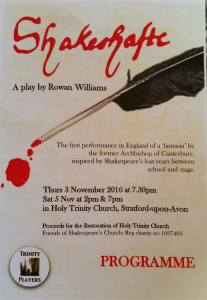 He lived and created his work during a period of religious turmoil; and scholars are left to guess at his true spiritual worldview, despite his association with Holy Trinity Church, Stratford-upon-Avon, and the fact that he was baptized and buried there.
He lived and created his work during a period of religious turmoil; and scholars are left to guess at his true spiritual worldview, despite his association with Holy Trinity Church, Stratford-upon-Avon, and the fact that he was baptized and buried there.
And so it was appropriate that Holy Trinity Church, the location of Shakespeare’s grave, should be the venue for the first performance in England of the play Shakeshafte by Rowan Williams which I went to see a few days ago. During the course of the play, a teenage Shakespeare debates with the Jesuit priest Edmund Campion, and I found this portrayal by the Trinity Players thought-provoking, poignant and inspiring.
The only reason why we think Shakeshafte may be our William Shakespeare is because a young man of that name is referred to as an in-house entertainer in the will of Alexander Hoghton of Hoghton Tower, Lancashire, in 1581. And it is known that Shakespeare’s schoolmaster, John Cottam, an ardent Catholic, recommended his pupil Will Shakeshafte and another boy, Fulk Gillom, to Alexander, for employment as tutors in his house and to provide entertainment. Alexander and his family were strong Catholics in Lancashire, a county renowned for being faithful to the “old religion” in a dangerous time of persecution against Catholics (and a county which was to see the infamous Pendle Witch trials in 1612, just 4 years before Shakespeare’s death).
So former Archbishop of Canterbury Rowan Williams works with the theory that this young Shakeshafte was indeed our William Shakespeare, during what scholars call one of the two “lost periods” of Shakespeare’s life. And that he met, talked and maybe even argued with Edmund Campion, the Jesuit priest who returned to England in 1580, spent time undercover at Hoghton Hall, was eventually betrayed, tried, and hanged, drawn and quartered in December 1581.
Scholars cannot tell what Shakespeare truly believed. Some think he was a closet Catholic and others that he was an atheist. The latter can cite quotes like:
Our remedies oft in ourselves do lie, Which we ascribe to heaven.
And thus I clothe my naked villany
With odd old ends stol’n forth of holy writ,
And seem a saint when most I play the devil.
and
The devil can cite Scripture for his purpose.
So in this play, the young poet – who is portrayed by actor Louis Osborne as wild, passionate and unruly – and the devout priest, played by Tim Raistrick, come face to face, and swap their views of life. And the poet’s view of life is clearly one that Rowan Williams shares, despite having been Archbishop of Canterbury: he as a poet wants to experience life in all its richness and diversity. He ‘holds a mirror up to nature’, listening to a variety of voices in his head and heart, unable to reduce them all to just one interpretation of the truth. And the play asks the question: Should we understand the truth as one grand central narrative to be imposed on life, or something that emerges in the dialogue between tradition and experience?(programme note by Anthony Woollard).
I think that Rowan Williams himself holds that view of life in tension with ‘the grand narrative’ of evangelical Christian belief. And this to me is a beautiful expression of what Shakespeare himself would have believed; a world view with which I too can empathise. And Shakespeare the poet would have held this view in amongst the dangerous religious turmoil of Elizabethan England, and it would be one that could only be hinted at in his poetry and plays, but never explicitly stated.
Which is probably the reason for the veiled remark to Horatio:
There are more things in heaven and Earth, Horatio, / Than are dreamt of in your philosophy.
Filed under: Authors I love, British, creative writing, faith, inspiration, life, literature, musings, people of inspiration, religion, SC Skillman, spirituality, stage drama, thoughts, UK, Writing Tagged: Christian, inspiration, poet, priest, Rowan Williams, SC Skillman author, Shakeshafte, Shakespeare, spiritual, worldview


November 1, 2016
The Writing Process for Creating a Novel In Less Than a Month
NaNoWriMo (National Novel Writing Month) begins today for 2016 and I will be once again taking this challenge – completing the first draft of my new novel “Director’s Cut”.  Here is an article I wrote when I was 3 weeks into the 2011 challenge, in order to write the first draft of my second novel “A Passionate Spirit”. Everything I said then still applies now; and my extra challenge is to take my own advice! I hope some of you who are setting out on this challenge today will find it a source of inspiration.
Here is an article I wrote when I was 3 weeks into the 2011 challenge, in order to write the first draft of my second novel “A Passionate Spirit”. Everything I said then still applies now; and my extra challenge is to take my own advice! I hope some of you who are setting out on this challenge today will find it a source of inspiration.
The task is: write a novel of at least 50,000 words in a month; and by the word “novel” we must mean, of course, “the first draft of a novel.” For I have not yet ever created a novel in a month; but in nine days time I will have done that very thing; and therefore I consider myself qualified to write the article.
Here are three tips to have that completed first draft of a novel in a month:
1) Do your preparation work before the month begins. Ideas will have been hatching in your mind for the last couple of years, perhaps; and now you have a ground plan. You have created a one-sentence storyline, and expanded it to a blurb and a synopsis and perhaps you have drawn up a list of scenes for your novel. Not everybody needs to have done this before they begin writing the novel. Some like to plunge into the writing with two or three characters and a conflict in mind, and let the story emerge. But I had already been thinking about my characters for a year or so before beginning my novel. And I know from experience what it’s like to allow your characters to take over. Characters will do that anyway, even if you have a plan. But I now believe having a plan is a very good way to start, even if the plan is radically changed by the time you’ve finished your first draft.
2) Begin writing, and don’t go back to edit. Control your desire to look over previous chapters and assess or improve them. This needs great discipline. Just keep writing even if you suspect what you are writing is rubbish, because you are going to go back over your manuscript anyway after the month is up and use it as the basis for your second draft.
3) Don’t fall into the trap of slacking or subsiding or falling away because your novel feels as if it’s sinking in the middle. Introduce something crazy or bizarre that occurs to you; just follow that instinct, introduce it into your plot, set your characters the task of dealing with it and keep on writing.
Those who find their minds go blank at the prospect of producing a full-length work of the imagination should remember this one thing: creating a first draft of fiction requires only motivation and courage. It requires you to forget everything negative you ever believed of yourself, and to believe in whatever ideas come to you, believe in them enough to incorporate them in your first draft. When you read your manuscript through in a month’s time, you may be amazed at what you came up with apparently “out of nowhere.”
n.b. this article, first published online in 2011, forms part of my upcoming non-fiction book, Perilous Path: a writer’s journey
Filed under: Books, British psychological suspense writer, creative writing, empowerment, inspiration, life, literature, New psychological thriller fiction, paranormal thriller fiction, places I love, psychological suspense fiction, SC Skillman, SC Skillman Author, Writing Tagged: characters, fiction, ideas, motivation, NaNoWriMo 2016, novel, SC Skillman, SC Skillman author, story, writing


October 25, 2016
Research in Southwark for Setting for New Novel
Last Saturday I was in Southwark, London SE1, researching locations for my new novel.















To me, the setting for a novel must have a strong emotional connection. My first two novels were set in the Cotswolds, near where I now live. My next novels will be set in London, near where I was born and brought up.
What a fascinating part of London Southwark is, rich in layers of history, the medieval squashed in with the 21st century, sparkling new towers, majestic cathedral, paupers graveyard and bustling market and Dickensian street names and eccentric pubs all crammed in together – and one of London’s most colourful and stimulating walks, along Bankside, from More London right through to the London Eye…..
But what I’m interested in isn’t just the tourist sites; it’s the atmosphere, the pubs, the unexpected small parks and gardens, the odd corners and street names. Here’s a selection from the many photos I took. And I’ll be back again, absorbing the feel of the place, and imagining my characters into it.
Filed under: British, British psychological suspense writer, buildings, creative writing, history, inspiration, life, London, New psychological thriller fiction, places I love, places of inspiration, SC Skillman, SC Skillman Author, UK, Writing Tagged: characters, history, imagining, London, new novel, novel locations, novel setting, Southwark, writing


October 18, 2016
Book Review: The Looking Glass House by Vanessa Tait
The story of Alice Liddell and the real Lewis Carroll (Charles Dodgson) is one that has inspired so much speculation and analysis since the creation of Alice in Wonderland in 1862; 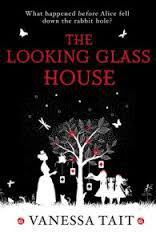 and here is another book on the subject, The Looking Glass House, this time a novel told by Alice’s great granddaughter Vanessa, which draws on family treasures and stories of the ‘original’ Alice. I found it a convincing picture of a stifled Victorian society with characters suffering from Victorian angst (especially Mrs Liddell and Mary Prickett the governess) along with a very pert, outspoken Alice and an enigmatic but compelling Mr Dodgson (aka Lewis Carroll).
and here is another book on the subject, The Looking Glass House, this time a novel told by Alice’s great granddaughter Vanessa, which draws on family treasures and stories of the ‘original’ Alice. I found it a convincing picture of a stifled Victorian society with characters suffering from Victorian angst (especially Mrs Liddell and Mary Prickett the governess) along with a very pert, outspoken Alice and an enigmatic but compelling Mr Dodgson (aka Lewis Carroll).
For me, this novel built up a picture of an intense, brilliant young man with a great love for children which never quite tipped over “the edge” (as we would define it today with our 21st century sensibilities), but could easily have done if Victorian restraint had not had such a strong hold on his character. Vanessa Tait’s book depicts the scene in which Mrs Liddell banished Mr Dodgson from the house, thus precipitating the rift between him and the Dean’s family.
Having considered it all I believe that if I had been in Mrs Liddell’s position, I may well have done the same. Alice herself is shown very much as an instigator and provocateur in her relationship with Mr Dodgson. The adult Alice’s silence on the subject throughout the rest of her life is something I could well understand – as the two Alice books quickly became hugely popular she would have been afraid to tarnish anybody’s vision of the stories by telling the truth about the circumstances in which they were created, which may have been misinterpreted. Mr Dodgson’s family, too, clearly felt the same, in tearing out of his diary the very pages which cover the time he created the first Alice story.
I was intrigued by the number of Amazon reviewers who gave The Looking Glass House low star ratings and said the book disappointed them, because it was not what they expected. I think they hoped the biographical reality behind it all would fully match up to the enchantment of the stories. As a writer myself I feel that knowing the biographical reality behind the creation of a story is interesting but in no way defines or encompasses the created story itself. The curious fact is that I identified at different times in the book with Mrs Liddell, Alice, and Mr Dodgson. I admired and enjoyed the pert outspokenness in Alice which other readers described as brattishness; and felt I could understand Mr Dodgson’s obsessive love for the company of children, and also Mrs Liddell’s fear of allowing the relationship to develop into Alice’s adolescence, and her sudden urge to banish him from the scene.
Above all the book made me feel that as I child I would love to have had a friend like Mr Dodgson because he was the sort of person children love – quirky, entertaining teasing, quixotic, fun, enigmatic.
Filed under: About Books I love, Authors I love, book reviews, Books, British, creative writing, history, life, love, musings, SC Skillman, thoughts, Writing Tagged: Alice in Wonderland, Alice Liddell, Charles Dodgson, Lewis Carroll, relationships, reviews, SC Skillman, The Looking Glass House, Vanessa Tait, writing 

October 11, 2016
Fun, Tranquility and Happiness on My Third Visit to Highgrove Garden
Last week I visited HRH the Prince of Wales’ garden at Highgrove for the third time.
Each time I’ve visited – the first time in pouring rain in August 2015, the second time near the end of the wildflower season in June 2016, and now in October 2016, we’ve been led by a different guide and each has chosen a different slant. On this occasion our guide (a gentleman in his eighties) told us that HRH the Prince of Wales takes his guides round the garden and tells them all the stories and points out the things he wants them to mention to the visitors. Inevitably, however, each individual will have his or her own angle onto the garden.
So this time I was able to notice not only those aspects of the garden this particular guide was focusing on, but those which carried stories told on my previous two visits. One of the tales told by today’s guide (tongue-in-cheek) portrayed the Prince as an unexpected visitor to Highgrove whose favourite occupation, having turned up without prior warning, is to hide behind the hedge and listen in on what visitors say about his garden. In fact most of the time the visitors are silent with either admiration, delight, puzzlement, bemusement or even, dare I suggest, indignation, when they realise that they are not in the Land of the Immaculate, and that weeds are not treated like public enemy number one in this garden,  moss is allowed to multiply to its fullest extent on stone, and different principles apply, other than those we might expect, perhaps from National Trust gardens, or those associated with Capability Brown.
moss is allowed to multiply to its fullest extent on stone, and different principles apply, other than those we might expect, perhaps from National Trust gardens, or those associated with Capability Brown.
This time I felt able to say which are most definitely my favourite aspects of the gardens at Highgrove. For those who have visited, this list will be meaningful, but for those who haven’t, then I suggest either reading this book on the subject, or just letting your imagination play with the images the list suggests:
I love the stumpery, and the little gnome that is to be found inside one of the stumps there; the temple garden, with its two statues to ward off evil spirits, and the network of dry sticks and twigs in the temple pediments, that manage to look like intricate wood carvings;
the temple garden, with its two statues to ward off evil spirits, and the network of dry sticks and twigs in the temple pediments, that manage to look like intricate wood carvings; 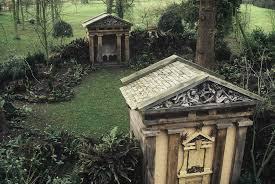 the goddess of the wood;
the goddess of the wood;  the wall of gifts; the four daughters of Odessa;
the wall of gifts; the four daughters of Odessa; 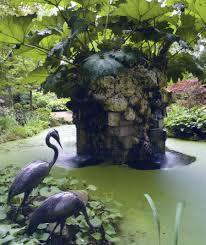 the pond with redundant stonework and limestone topped by gunnera, the topiary frog and snail.
the pond with redundant stonework and limestone topped by gunnera, the topiary frog and snail.
To me, this is a garden that is playful, quirky, eccentric; a fantasy made real by someone who has the means, the time, patience and heart to achieve it. As I wander through the garden, I can’t help expecting trick fountains – such as those which King Ludwig of Bavaria incorporated into his own garden, in the gardens of his dreamlike palace.
Whenever I go to Highgrove and walk around the garden I feel happy: the garden combines a sense of fun with tranquility, surprise and ingenuity. It’s a garden with a sense of humour, which can take a joke against itself, and a garden with a soul.
Have you ever been to Highgrove? If so, I’d love to hear your thoughts on the garden there; please share them in the comments below.
(please note: the photos here are not my own; visitors to the Highgrove estate are not allowed to take photographs)
Filed under: British, design, garden design, inspiration, life, love, musings, places of inspiration, SC Skillman, SC Skillman Author, spirituality, thoughts, UK Tagged: design, dream, garden, happy, Highgrove, HRH the Prince of Wales, humour, inspiration, SC Skillman, soul


September 20, 2016
Beatles Shine with Passion and Energy in New Documentary “8 Days a Week: the Touring Years”
How young, innocent, and naive they were, aged in their early twenties: cheeky and endearing. As Paul McCartney puts it, “At the beginning it was all very simple. By the end it had become very complicated.”
And in the Beatles new documentary “8 Days a Week: The Touring Years” we saw a transformation rather similar to the one which we witnessed in Diana, Princess of Wales – a transition from youth and innocence to another state of being harder, more cynical and worldly-wise, more knowing and more guarded, more self-protective. It is an inevitable transition in many ways, one we all make, and yet we never see our own transition writ large upon the screen, projected before the public gaze, as with those who become famous.
In this respect it is their story, but our story too. There were many moments when the whole cinema audience burst out laughing at John’s humour. There was a wonderful little scene when John told a US reporter that his name was Eric, and the reporter took him seriously, and then kept calling him Eric, and John said, “No, John” and the reporter said, “I thought you were Eric,” and John said to him in a low voice, “I was joking”, as if he’d finally taken pity on the reporter.
The one thing that shines out of the new Beatles documentary 8 Days a Week is the fact that with the creative partnership that was the Beatles, we didn’t get just 100% passion and energy; instead, we got 400%. Their love of what they were doing was paramount; at the beginning they were just a “great little band who loved writing songs and playing music, and having a laugh.” The documentary was inspirational, joyous, funny, moving, thought-provoking, emotional, touching, heart-warming.
There are so many different wonderful things about this documentary. As a former Beatles fan myself (who was never, alas, allowed to go to a live Beatles concert, and so was never one of those screaming fans), I watched it with a big smile on my face, laughing often, delighted in being reminded how funny John was, touched by the poignant moments, and the way each corroborated the others in superbly-cut-in interviews which were recorded individually and at different times. George’s interview was particularly moving; there was so much depth to him. He made the most thought-provoking remark when he said, “We were torn out of our youth, and force-grown like rhubarb.”
The other thing that struck me was how vulnerable they were at their live concerts – no effective protection at all. At the end of the concert at Shea Stadium they ran to a limo and sped off. But if they’d had to run from the stage to the dressing room area, they would have been torn to pieces by fans breaking through the barriers, and being chased by fleet-footed policemen (who must have got the most exercise in their career, being on guard at a Beatles concert).
As we watched the footage of the Shea Stadium concert, digitally remastered, so we could hear the music the Beatles made (which they never heard at the time, as the music was drowned out by the screams), we saw many wonderful cameos of audience behaviour. There were girl screaming in hysterics, overwhelmed by emotion, to a point where they seemed to be in distress; others screaming just as loud, but in ecstacy; every so often there was an indifferent looking male, standing there with immobile face in the midst of mass fervour ; other men just smiling quietly; there was a mother handing out tissues to her overwhelmed daughters; girls just listening with smiles of joy on their faces; others gazing in rapture, in a state of absolute bliss. And standing at the side, quiet, restrained, appraising, watchful: Brian Epstein, of whom Paul said, “The thing about Brian was – he was Class. Liverpool Class. That was what Brian was. Well-spoken, well dressed.”
And in the middle of this, John’s humour into the microphone: “oooh, look at her.” And Paul’s charm, ever-present then, exactly as it is now 50 years later, when he performs to mass audiences: “I want everybody over there, and everybody over there – yes, you, all of you, and all of you over there, to clap along.” When we saw him at Cardiff Millennium Stadium a few years ago, he said, “How are you all getting along up there at the back?”
And the fabulous cheeky, innocent humour at press conferences. When the boys were asked, “Why do you think you are so popular and successful?” John replied, “we really haven’t got the slightest idea. If we knew, we’d start another group, and become managers.”
And then there was the bizarre period when John caused an international incident by saying the Beatles were more popular than Jesus. At the press conference where he knew he would have to apologise, we listened to what he said, and had that terrible feeling that John was trying to dig himself out of a hole by digging himself further into it. As Paul said, “You could tell he wanted to finish with a joke but knew he couldn’t… we were all scared, and we all knew it was very serious. We had all been bought up with a religious background.”
When the boys were asked to account for their fans’ reaction to them, and the screaming, they appeared bemused. They observed that the screams grew louder when they shook their heads. In fact, body language was how Ringo managed to know whereabouts in a song they were, in the huge concerts: he couldn’t hear the music at all. He said, “I watched Paul’s arse, and John’s arse, and when they shook their heads and when they tapped their feet,” and that was how I worked out whereabouts in the song we were.” And astonishingly, when listening to the digitally remastered recording, we can see that despite not being able to hear each other, they were all in tune, and together. Paul observed how instinctive they were with each other, musically, because of their close relationships, and the fact that they knew each other so well. They were good at what they did he said, simply because they did it so much.
There was such a poignant contrast between the first concerts the Beatles did, and the concert at Shea Stadium, and the very last public performance ever on the rooftop of the Apple offices in Savile Row. As people gathered in the street down below and watched, curious, bemused, and silent, it was sobering to reflect that they had no idea they were witnessing the very last pubic performance ever, of what history would judge to be the best pop group ever, and the most astonishing social phenomenon of the twentieth century. What a huge historical moment that was – and all were unconscious of it at the time.
Filed under: British, history, life, love, music, musings, people of inspiration, popular music, religion, SC Skillman, SC Skillman Author, thoughts, UK Tagged: 8 Days a Week, creative, inspirational, love, popular, relationships, SC Skillman, successful, The Beatles, The Beatles documentary


September 13, 2016
“Dream” Book Buyers at Festival of Crafts, Coombe Abbey
Thank you to the “dream buyers” who bought my books on Saturday at the Coombe Abbey Festival of Crafts. 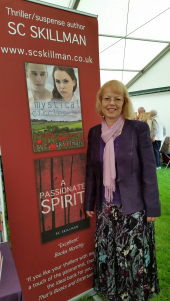 They needed no promotional chat of any kind from me, (which I’ve discovered is counter-productive), studied my banner, reviews and blurbs closely, and recognised that the stories were just their type of thing.
They needed no promotional chat of any kind from me, (which I’ve discovered is counter-productive), studied my banner, reviews and blurbs closely, and recognised that the stories were just their type of thing.
Abigail, Jamie and I enjoyed our time at the local author stall in the Craft Marquee at the festival despite the rain and damp – though I feared my books might be starting to curl!
Thank you too to another stallholder, Holly Webster, who came over to me to look at my books and to chat about her own urban dark fantasy novels. I’ve looked her up on Amazon and though the horror element in her novel Blood Borne is much darker than my usual taste, curiosity may lead me to download on my Kindle!
Thank you also to the lady who came over and bought a copy of “Mystical Circles” and said, “I shall read this today and review it tomorrow.”
Now all I need is for buyers like this to be increased a hundredfold!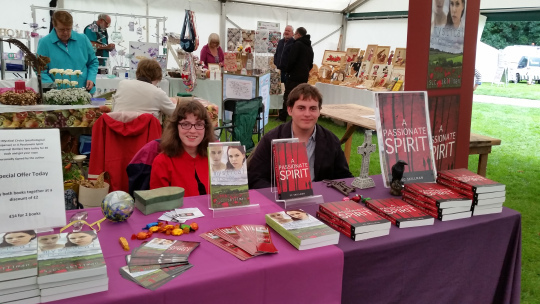



Filed under: book reviews, Books, British, British psychological suspense writer, creative writing, life, Mystical Circles, paranormal thriller fiction, SC Skillman, SC Skillman Author, UK, Writing Tagged: book review, book signing, books, Coombe Abbey festival of crafts, mystical circles, novel, passionate spirit, SC Skillman, SC Skillman author, stories


September 6, 2016
The Joys of a Great Building, and its Healing Power to Relieve the Stresses of Our Lives: Beautiful Pershore Abbey
As the mother of a son with autism, I have throughout his life acted as an advocate, carer, companion, supporter. One of his difficulties is taking unfamiliar journeys alone. 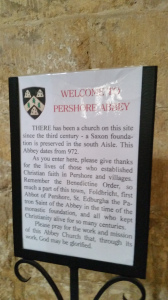 Now aged 18, he has just started a new course in Horticulture at Pershore College in Worcestershire.
Now aged 18, he has just started a new course in Horticulture at Pershore College in Worcestershire.
Yesterday we met what was, for both of us, a challenge: we navigated the minefield of getting from Warwick to Pershore College by 9.30 am (a three hour journey by public transport). It was a challenge for me because, as a car-owner, I’m used to driving everywhere and am unfamiliar with public transport, especially in rural areas. Having recently been involved in a car accident, I’m currently without a car. So we both set out, expecting to find the buses arriving and departing according to the timetables, and I ended up with feelings of frustration, anger and even betrayal from the difficulties and unexpected events we encountered (all of them caused by human error). I thought to myself, ‘I must write about this…. if I was a satirical novelist, I’d write a brilliantly comic piece about it.’ Even as I raged impotently against the bus companies of Warwickshire and Worcestershire, the infuriating details of this journey struck me as perfect material for a comic novelist’s take on life.
Having delivered my son an hour late at the college (slightly relieved by the discovery that several of the other students had also had trouble with public transport this morning, and were late, or still hadn’t arrived – so my son wasn’t alone, and hadn’t missed anything important) – I walked into Pershore to explore the town before returning to the college later in the day.
I was thinking to myself, “this is a lovely place” but my nerves were still so jangled by our recent journey, and the thought that he’d have to go through this 3 days a week for the next academic year. I found myself reflecting on how so many people in our society seem to operate by keeping one area of information separate from others, and they don’t coalesce, responding flexibly in relation to other facts. It reminded me of a recent comment on Facebook I had read by a fellow-writer, observing that she regarded the world as largely insane, as a matter of course.
Then I found Pershore Abbey.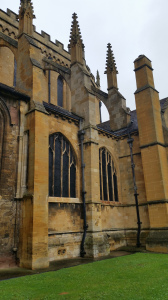
First of all I walked all around the exterior of the Abbey.
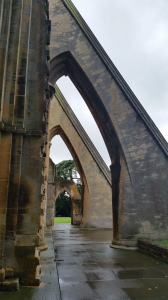
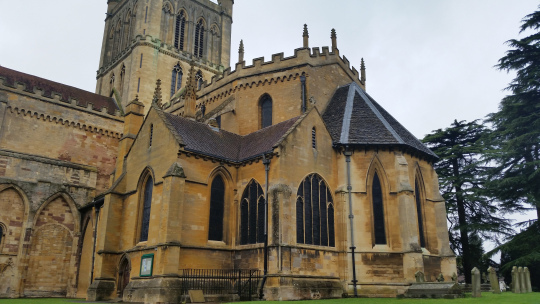 Then I walked in through the west door, and this was the sight that met my eyes.
Then I walked in through the west door, and this was the sight that met my eyes.

Immediately, I thought: Sanity. It was as if I had been trapped in a stifling, enclosed cell and now entered a place where there was fresh air, living water, and a vision of life that transcended all I had been experiencing for the last few hours. I felt released, opened up, by the beauty of this space.
And this is the purpose of great religious buildings, and the goal of all truly noble architecture – to draw you in and welcome you as you enter, to make you feel that you are accepted, whoever you are, and whatever state you’re in, and to live your eyes upwards, so that you may transcend the troubles of this world, and indeed, see this life in divine perspective.
Filed under: architecture, British, British psychological suspense writer, buildings, faith, history, inspiration, life, musings, places of inspiration, religion, SC Skillman Tagged: architecture, beauty, divine perspective, healing power, in this life, life, religious buildings, space, transcend





